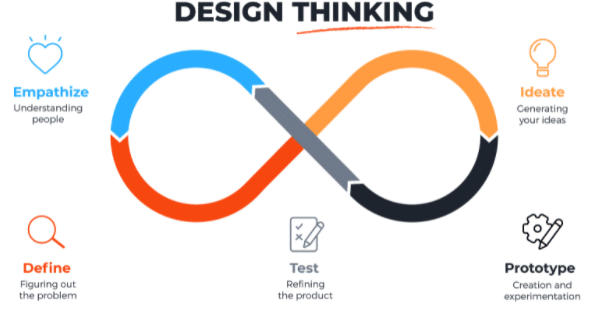It’s well known that design thinking is a creative problem-solving process, which focuses on reaching solutions that were previously inaccessible. To the trained eye, this may ring a bell as a common goal of innovative thinking as well. In reality, design thinking is a process that overlaps with traditional innovation in many different ways, making it extremely useful for innovative ideation. In this article, we’ll discuss design thinking and the impact that using it can have on the innovative process.

Design Thinking and Innovation
In order to understand how design thinking promotes innovation, we first have to grasp what it is. Design thinking is defined on IdeaScale Whiteboard as: “a process in which teams attempt to understand their customer, reimagine problems, and brainstorm solutions previously out of reach. By doing this, teams can creatively define new possibilities to find solutions.”
This definition already demonstrates that design thinking inherently overlaps with many of the pipelines that are associated with innovation. Below we’ll talk about some of the ways that design thinking promotes and stimulates innovation.
Just like innovation, the design thinking mindset is solutions-oriented rather than problem-oriented. This means using design thinking to create possible solutions will usually involve potential sources of innovation, and that the solutions created will often be innovative in their own right
Takes a Holistic View of Problems
Design thinking is a process that focuses on finding solutions that were previously inaccessible. In order to do this, you need to be able to step back from the situation and analyze it from a different perspective. Design thinking uses specific visualization techniques that expand the scope of possibilities, and through this, it is able to develop unique solutions.
One of the reasons it’s easier to find innovative solutions through design thinking is because it is focused on the solution rather than the problem. When you think about the problem too much, it can restrict your ability to locate other routes to a sustainable solution. Design thinking is a way to circumvent this struggle and create innovative solutions. This ability to stimulate unique solutions rather than stagnant ones is a reason design thinking overlaps so well with innovation.
Allows for Recalibration and Revisitation of Steps
Design thinking is a process, not a single step. There are many different sections that complete the larger design thinking process and each one is vital. This process generally has 5 main steps: Empathize, Define, Ideate, Prototype, and Test. Each step has a unique significance in locating problems and defining solutions, but they shouldn’t be confused with an ordinary step-by-step solution.
The process of design thinking enables the revisitation of ideas and the cyclical process of problem-solving. Instead of working to find the problem, testing a solution, deploying it, and subsequently washing your hands of the whole situation, design thinking requires serious thought about each step and their unique intersections.
Some teams might begin by ideation because they already have a firm grasp on the problem, only to later realize it requires more foresight and research. Other teams might work in reverse. The key point here is that the design thinking process is a cycle of innovation that is meant to be revisited and recharged often, allowing for new ideas and perspectives to influence the cycle of ideas at any moment.
Uses Visual Elements
One way design thinking enables innovation is through the physical methods of ideation. Most typical ideation exercises surround brainstorming and textual ideation, which is inherently the easiest way to get down as many ideas as possible. This method, while useful in some circumstances, is not the preferred approach for the design thinking strategy.
Design thinking focuses on the visualization of ideas and emphasizes visual elements as much as possible in order to provide an alternate method of brainstorming. By having people utilize visual elements to explain their ideas and brainstorm, it opens the door to different interpretations and trains of thought that are only unlocked thanks because of the shared visualization.
Visualizing ideas means they are communicated in an entirely different way, and this is very helpful to other people picking up and understanding these ideas. When communicated visually, new ideas and understandings are much more likely to occur, effectively stimulating the innovative ability of teams using design thinking.
Design Thinking and Online Whiteboards
Design thinking is a creative problem-solving process that centers around visualization and free expression as a way to create unique solutions. While this can be done fairly easily in person, it requires a shared online space to achieve the same results online.
Using online whiteboards is a natural stepping stone for teams looking to implement design thinking online, and we will highlight some of these advantages here.

Fast visualization
Online whiteboards do a great job of creating snappy visual collaboration, something that is maximized when using traditional whiteboards. Virtual whiteboards do a great job of replicating the capabilities of traditional whiteboards while expanding the possibilities as well.
An example of these expanded possibilities is the different modes of interaction you can use. You can draw items, upload images, utilize templates, and other text solutions all on the same interface. Using these different modes of interaction is an incredible tool for design thinking exercises, allowing people to utilize any kind of design thinking exercise they want to use.
Digital permanence
Innovation often occurs in a flash of brilliance, and soon after, if not preserved, it can disappear. Online whiteboards save every edit and progress in digital permanence so the sparks of innovation will never be lost.
This digital permanence is crucial to design thinking, and it also allows the board to be revisited, edited, and changed many times over. As we know, design thinking is a cycle that requires constant visitation, so being able to use a board that is readily accessible from anywhere is a huge positive.

Shared instantly with anyone
The last advantage online whiteboards have with design thinking is their ability to engage large amounts of people in a shared collaborative space.
Design thinking is a process that flourishes when people are able to compare ideas and solutions to their own perspectives, and with online whiteboards, this comparison is incredibly easy. You can invite anyone to the board, regardless of their relation to your organization, and within seconds they can be participating and providing feedback on other contributions.
This reality makes online whiteboards great collaboration platforms and super helpful to any team utilizing design thinking exercises.
Conclusion
Design thinking is a great solution-building process and thanks to its visualization and iterative ability, it goes hand in hand with innovation. If you enjoyed this guide make sure to check out our comprehensive overview of design thinking on IdeaScale Whiteboard. You can also take a look at our popular guides to virtual workshops if you need inspiration on how to apply these techniques.
Most Recent Posts
Explore the latest innovation insights and trends with our recent blog posts.













